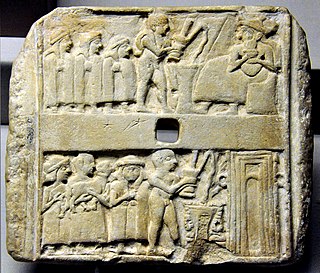English usually refers to:

An ideogram or ideograph is a graphic symbol that represents an idea or concept, independent of any particular language, and specific words or phrases. Some ideograms are comprehensible only by familiarity with prior convention; others convey their meaning through pictorial resemblance to a physical object, and thus may also be referred to as pictograms.

Akkadian is an extinct East Semitic language that was spoken in ancient Mesopotamia from the third millennium BC until its gradual replacement by Akkadian-influenced Old Aramaic among Mesopotamians by the 8th century BC.

Sumer is the earliest known civilization in the historical region of southern Mesopotamia, emerging during the Chalcolithic and early Bronze Ages between the sixth and fifth millennium BC. It is also one of the first civilizations in the world, along with ancient Egypt, the Caral-Supe civilization, the Indus Valley civilization, the Minoan civilization, and ancient China. Living along the valleys of the Tigris and Euphrates, Sumerian farmers grew an abundance of grain and other crops, the surplus from which enabled them to form urban settlements. Proto-writing dates back before 3000 BC. The earliest texts come from the cities of Uruk and Jemdet Nasr, and date to between c. 3500 and c. 3000 BC.

The terms Hebrews and Hebrew people are mostly considered synonymous with the Semitic-speaking Israelites, especially in the pre-monarchic period when they were still nomadic. However, in some instances it may also be used in a wider sense, referring to the Phoenicians, or to other ancient groups, such as the group known as Shasu of Yhw on the eve of the Bronze Age collapse, which appears 34 times within 32 verses of the Hebrew Bible. It is sometimes regarded as an ethnonym and sometimes not.
Assyrian language may refer to:
Akkadian literature is the ancient literature written in the Akkadian language in Mesopotamia during the period spanning the Middle Bronze Age to the Iron Age.

The Amarna letters are an archive, written on clay tablets, primarily consisting of diplomatic correspondence between the Egyptian administration and its representatives in Canaan and Amurru, or neighboring kingdom leaders, during the New Kingdom, between c. 1360–1332 BC. The letters were found in Upper Egypt at el-Amarna, the modern name for the ancient Egyptian capital of Akhetaten, founded by pharaoh Akhenaten (1350s–1330s BC) during the Eighteenth Dynasty of Egypt. The Amarna letters are unusual in Egyptological research, because they are mostly written in a script known as Akkadian cuneiform, the writing system of ancient Mesopotamia, rather than that of ancient Egypt, and the language used has sometimes been characterised as a mixed language, Canaanite-Akkadian. The written correspondence spans a period of at most thirty years.

Mesopotamian Arabic, also known as Iraqi Arabic, is a continuum of mutually-intelligible varieties of Arabic native to the Mesopotamian basin of Iraq as well as spanning into Syria, Iran, southeastern Turkey, and spoken in Iraqi diaspora communities.
Old Babylonian may refer to:
Middle Assyrian refers to the Middle Assyrian period of the Ancient Near East, ca. 16th to 10th centuries BC. It may refer to:
There are a number of languages spoken in Iraq, but Mesopotamian Arabic is by far the most widely spoken in the country.

Sumerian literature constitutes the earliest known corpus of recorded literature, including the religious writings and other traditional stories maintained by the Sumerian civilization and largely preserved by the later Akkadian and Babylonian empires. These records were written in the Sumerian language during the Middle Bronze Age.

Sumerian religion was the religion practiced and adhered to by the people of Sumer, the first literate civilization of ancient Mesopotamia. The Sumerians regarded their divinities as responsible for all matters pertaining to the natural and social orders.
Ancient Semitic-speaking peoples or Proto-Semitic people were Western Asian people who lived throughout the ancient Near East, including the Levant, Mesopotamia, the Arabian Peninsula, and the Horn of Africa from the 3rd millennium BC until the end of antiquity.

The Early Period refers to the history of Assyrian civilization of Mesopotamia between 2500 BCE and 2025 BCE. It is the first of the four periods into which the history of the Assyrian civilisation is traditionally divided. The other periods are the Old Assyrian Empire, the Middle Assyrian Empire and the Neo-Assyrian Empire.
This page is based on this
Wikipedia article Text is available under the
CC BY-SA 4.0 license; additional terms may apply.
Images, videos and audio are available under their respective licenses.








